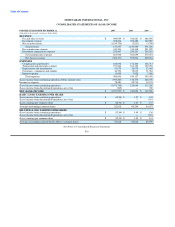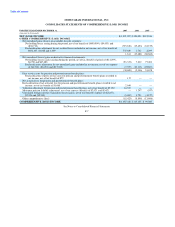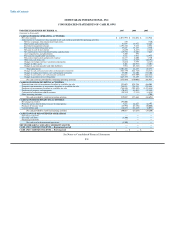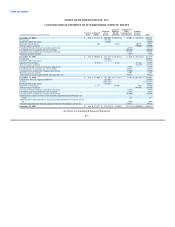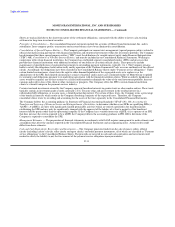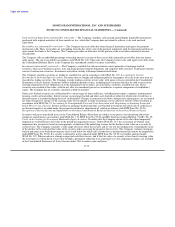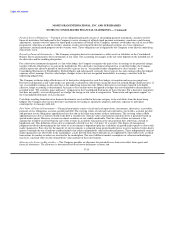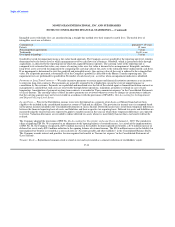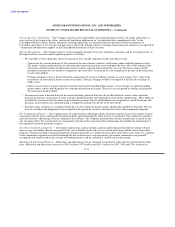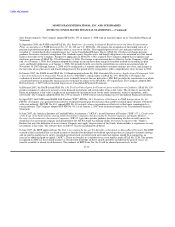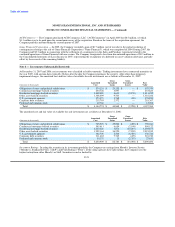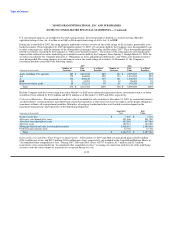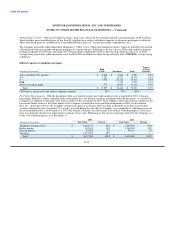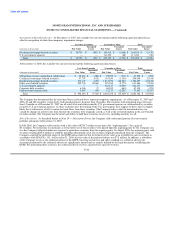MoneyGram 2007 Annual Report Download - page 90
Download and view the complete annual report
Please find page 90 of the 2007 MoneyGram annual report below. You can navigate through the pages in the report by either clicking on the pages listed below, or by using the keyword search tool below to find specific information within the annual report.
Table of Contents
MONEYGRAM INTERNATIONAL, INC. AND SUBSIDIARIES
NOTES TO CONSOLIDATED FINANCIAL STATEMENTS — (Continued)
Intangible assets with finite lives are amortized using a straight-line method over their respective useful lives. The useful lives of
intangibles assets are as follows:
Customer lists primarily 9-15 years
Patents 15 years
Noncompetition agreements 3 years
Trademarks 36-40 years
Developed technology 5 years
Goodwill is tested for impairment using a fair-value based approach. The Company assesses goodwill at the reporting unit level, which is
determined to be the lowest level at which management reviews cash flows for a business. Goodwill, which is generated solely through
acquisitions, is allocated to the reporting unit in which the acquired business operates. The carrying value of the reporting unit is
compared to its estimated fair value; any excess of carrying value over fair value is deemed to be an impairment. Intangible, and other
long-lived, assets are tested for impairment by comparing the carrying value of the assets to the estimated future undiscounted cash flows.
If an impairment is determined to exist for goodwill and intangible assets, the carrying value of the asset is reduced to the estimated fair
value. For all periods presented, substantially all of the Company's goodwill is allocated to the Money Transfer reporting unit. The
impairment tests are performed for goodwill in November of each fiscal year, as well as when an impairment indicator is identified.
Payments on Long-Term Contracts — We make incentive payments to certain agents and financial institution customers as an incentive
to enter into long-term contracts. The payments are generally required to be refunded pro rata in the event of nonperformance or
cancellation by the customer. Payments are capitalized and amortized over the life of the related agent or financial institution contracts as
management is satisfied that such costs are recoverable through future operations, minimums, penalties or refunds in case of early
termination. Amortization of payments on long-term contracts is recorded in "Fees commission expense" in the Consolidated Statements
of (Loss) Income. The carrying values of these incentive payments are reviewed whenever events or changes in circumstances indicate
that the carrying amounts may not be recoverable in accordance with the provisions of SFAS No. 144, Accounting for the Impairment
and Disposal of Long-Lived Assets.
Income Taxes — Prior to the Distribution, income taxes were determined on a separate return basis as if MoneyGram had not been
eligible to be included in the consolidated income tax return of Viad and its affiliates. The provision for income taxes is computed based
on the pretax income included in the Consolidated Statements of (Loss) Income. Deferred income taxes result from temporary differences
between the financial reporting basis of assets and liabilities and their respective tax-reporting basis. Deferred tax assets and liabilities are
measured using the enacted tax rates expected to apply to taxable income in the years in which those temporary differences are expected
to reverse. Valuation allowances are recorded to reduce deferred tax assets when it is more likely than not that a tax benefit will not be
realized.
The Company adopted the provisions of FIN No. 48, Accounting for Uncertainty in Income Taxes, on January 1, 2007. The cumulative
effect of applying FIN No. 48 is reported as an adjustment to the opening balance of retained income. As a result of the implementation
of FIN No. 48, the Company recognized a $29.6 million increase in the liability for unrecognized tax benefits, a $7.6 million increase in
deferred tax assets and a $22.0 million reduction to the opening balance of retained income. The $29.6 million increase in the liability for
unrecognized tax benefits is recorded as a non-cash item in "Accounts payable and other liabilities" in the Consolidated Balance Sheets.
The Company records interest and penalties for unrecognized tax benefits in "Income tax expense" in the Consolidated Statements of
(Loss) Income.
Treasury Stock — Repurchased common stock is stated at cost and is presented as a separate reduction of stockholders' equity.
F-16


